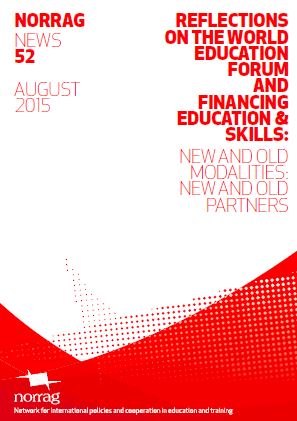NORRAG NEWS 52: Reflections on the World Education Forum / Financing Education and Skills By NORRAG
By NORRAG.
 The August 2015 issue of NORRAG News (NN) – NN52 – covers two topics:
The August 2015 issue of NORRAG News (NN) – NN52 – covers two topics:
- It contains 13 articles that reflect critically on the World Education Forum (WEF), just held in Incheon, South Korea during 18-22 May 2015.
- It also contains 36 articles that look at the place of education and skills financing against the backdrop of the world’s next development agenda from September 2015 and the 3rd International Conference on Financing for Development (FFD) which was held on 13th-16th July 2015 in Addis Ababa.
Though much of what is happening in education and skills financing is arguably not directly linked to the post-2015 agenda, the different routes towards post-2015 all have implications for finance, and especially official development assistance (ODA) financing. Thus the national and regional Education for All (EFA) assessments which came together in the World Education Forum in Incheon Korea (May 2015), a year after the Muscat Agreement, all have financing dimensions. Incheon’s ambitious Goal and draft Targets, most of which found their way into the agreed Outcome Document of the September 2015 Sustainable Development Summit, also have very serious implications for financing.
The EFA Global Monitoring Report 2015: Education for All: Achievements and Challenges 2000-2015, contained a key chapter on aid and financing; it analysed the financial resources available to education, taking into account the roles of governments, international development institutions, households and the private sector.
The Open Working Group’s (OWG) Report (July 2014) and the UN Secretary General’s Post-2015 Synthesis Report (December 2014) have both underlined the importance of ODA financing targets and national financing commitments. The post-2015 intergovernmental negotiations January-July 2015 also addressed the financing dimension of the post-2015 agenda, even as they waited for the outcome of the Financing for Development Conference in mid-July.
Beyond these different routes towards post-2015, there are financial challenges more generally for resource mobilization for education. These include demands upon ODA for DAC donors, as well as new targets for the Global Partnership for Education, and other initiatives such as the Global Education First Initiative. There have also been renewed concerns about the priority of domestic financing for education. Emerging non-DAC donors, including the BRICS countries, will be under pressure to relate to any new financing agreements post-2015. So too will private philanthropic foundations.
Apart from these, and from the continued priority focus on the funding of education as a global public good, it is crucial to look critically at the world of private education, including the mixes of the public and the private in shadow education environments, as well as the so-called low-fee private school regimes, and the no-fee school provision by non-government and civil society organizations. The extent to which the private sector and private firms are part of the solution to education finance needs to be carefully interrogated. This includes the interest several bilateral donors have in relating much more closely with the private sector.
It is also necessary to examine what has happened to the apparently promising world of innovative financing for education. Which of the many creative schemes are actually delivering finance for education, and what others have the realistic potential to do so?
There is also a need to review the particular challenges of the financing of education in conflict, post-conflict and emergency situations.
Running through the review of various financing modalities and mechanisms, we need to highlight specific financing approaches which are more suited to some sub-sectors of education and skill, than to others. Again, there are particular schemes related to life-long learning, technical and vocational education and training (TVET) financing and even early childhood education financing.
A final, but key concern, in this issue of NN relates to the way different types of financial resources for education are allocated. Development partner concerns with resource allocation and monitoring of education have produced a series of schemes which have promised a good deal, from Cash on Delivery to Results-based Financing for education, and skills development funds. Running through all of these is the concern with value for money (See NN 47). But, perhaps even more importantly, there is the need for further analysis of the way that domestic resources for education are actually allocated; how efficiently and equitably are these managed, now that these have become a central priority of financing for development?
>>See the full list of articles in NORRAG NEWS 52
>>View all NORRAG Blogs on Agenda 2030
NORRAG (Network for International Policies and Cooperation in Education and Training) is an internationally recognised, multi-stakeholder network which has been seeking to inform, challenge and influence international education and training policies and cooperation for almost 30 years. NORRAG has more than 4,200 registered members worldwide and is free to join. Not a member? Join free here.

Pingback : Reflections as a new education era dawns | World Education Blog